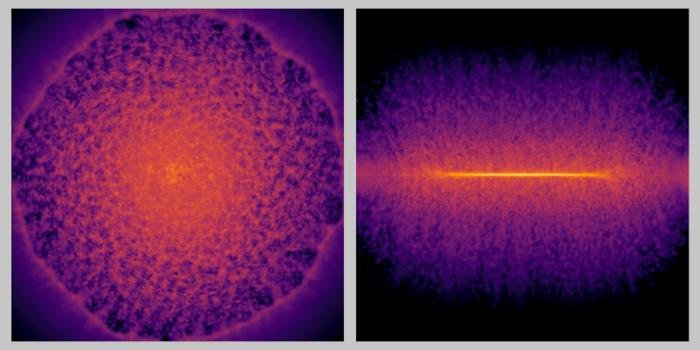For the first time, scientists have simulated our Milky Way galaxy star by star, and they pulled it off with help from artificial intelligence.
In work presented at the SC25 international supercomputing conference, researchers from the RIKEN Center for Interdisciplinary Theoretical and Mathematical Sciences in Japan, The University of Tokyo, and Universitat de Barcelona describe a new way to model the Milky Way using more than 100 billion individual stars over 10 thousand years of simulated time.
The team combined traditional physics-based simulations with a deep learning surrogate model, letting them run a galaxy scale experiment more than 100 times faster than previous state of the art efforts on over 7 million CPU cores.
If you want to simulate a whole galaxy, you have to deal with very different speeds and sizes at once. On one hand there is the slow swirl of the Milky Way over billions of years. On the other hand there are brief but dramatic events like supernova explosions, where a single massive star can blast gas outward at extreme temperatures. Capturing those fast changes usually forces the computer to take tiny time steps, which makes the whole simulation crawl and limits how detailed it can be.
Until now, that trade off meant that each simulated “particle” often stood in for a whole cluster of stars. Small scale details were smoothed out, and big events like supernovae were averaged rather than followed in full. The new method breaks through that barrier. Instead of slowing the whole galaxy down every time a star explodes, the team uses AI to handle what happens in the small bubble of gas around each supernova, while the main simulation keeps moving at a steady pace.
How AI Helps A Galaxy Run On Time
The deep learning surrogate model is essentially a trained shortcut. The researchers first ran many high resolution simulations of a single supernova, then used those results to teach a neural network how gas density, temperature, and motion change in the 100 thousand years after an explosion. In the full Milky Way run, whenever a star is about to go supernova, the code sends a small cube of surrounding gas to a pool of AI nodes, which predict how that region will evolve. The main simulation does not have to wait for tiny time steps, so it can keep computing the gravity and gas flow for the rest of the galaxy.
“I believe that integrating AI with high performance computing marks a fundamental shift in how we tackle multi scale, multi physics problems across the computational sciences,” says Hirashima.
This division of labor pays off in raw speed. Using conventional methods, simulating 1 million years of Milky Way evolution at this resolution would take about 315 hours. With the AI assisted approach, it takes only 2.78 hours. That means a 1 billion year run that would once have been wildly unrealistic, on the order of 36 years of real time, could now be completed in about 115 days on a top tier supercomputer.
From Galaxy Lab To Climate Lab
The authors point out that the same idea could help in many other fields. Weather and climate models, for example, also have to link small, fast changing events like thunderstorms with slow, planet scale trends. Ocean models and turbulence simulations face similar mismatches between local detail and global behavior. Replacing the most expensive small scale pieces with well trained surrogate models could make it possible to run more detailed forecasts and longer simulations without exploding the compute bill.
“This achievement also shows that AI accelerated simulations can move beyond pattern recognition to become a genuine tool for scientific discovery, helping us trace how the elements that formed life itself emerged within our galaxy.”
For now, the Milky Way result is a proof of concept that our home galaxy can finally be followed star by star, with realistic supernova feedback and gas flows, rather than as a rough collection of averaged chunks. It hints at a future where AI does not just label data from telescopes, but helps build the virtual universes scientists use to understand how stars, planets, and maybe life itself came to be.
SC25 Proceedings: 10.1145/3712285.3759866
If our reporting has informed or inspired you, please consider making a donation. Every contribution, no matter the size, empowers us to continue delivering accurate, engaging, and trustworthy science and medical news. Independent journalism requires time, effort, and resources—your support ensures we can keep uncovering the stories that matter most to you.
Join us in making knowledge accessible and impactful. Thank you for standing with us!


